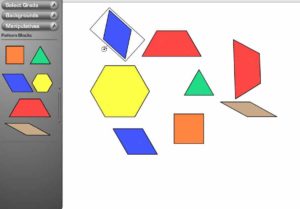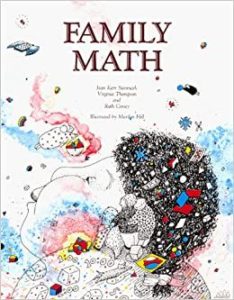 |
From UC Berkeley’s Lawrence Hall of Science, Family Math, by Jean Stenmark, Virginia Thompson, and Ruth Cossey (Equals Series), promotes math as an enriching whole-family activity. This 300+-page information and activity collection promotes understanding of basic arithmetic, logical thinking, probability and statistics, geometry, measurement, and calculator math. The book also contains reproducible game boards, hundred charts, graph paper, and a fill-in-the-blank calendar. Great for a range of ages. |
| |
Also see the sequel, Family Math II, for ages 5-12. |
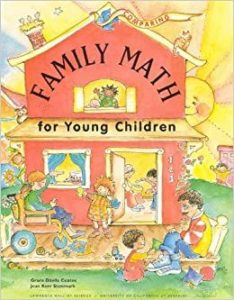 |
In the same series, Family Math for Young Children (Grace Coates and Jean Stenmark; Lawrence Hall of Science, 1997) is a creative investigative approach to early math, concentrating on such skills as counting, estimating, comparing, measuring, shape recognition, directions, logic, and sorting. Sample activities include making jigsaw puzzles, making (and sorting) a stamp collection, making and playing number games, playing shadow games, measuring yourself (and family and friends) with adding machine tape, and designing a quilt patch. All instructions, game boards, matching cards, and number charts are included in the book. For each activity, there’s an explanation of the math skills involved, a materials list, and complete instructions. For ages 3-7. |
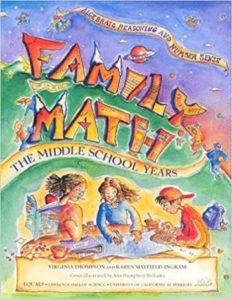 |
Family Math: The Middle School Years (Lawrence Hall of Science, 1998) concentrates on activities intended to inculcate algebraic thinking and number sense. Kids explore simultaneous equations with a game of Flowerpots; study area and perimeter with pentominoes and polyominoes; learn a series of clever tricks for quick mental arithmetic; study fraction/decimal equivalents with a game of Towers; tackle greatest common divisors with the Game of Euclid; and fool around with fraction calculators. Game boards and patterns are included in the text; there is also a list of additional family math resources and a description of the math concepts ordinarily covered in the middle school. For ages 10-14. |
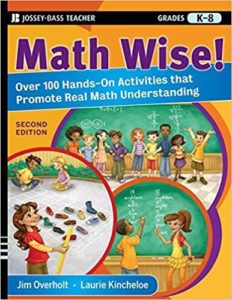 |
By James Overholt and Laurie Kincheloe, Math Wise! (Jossey-Bass, 2010) is a collection of over 100 hands-on activities designed to promote “real math understanding.” For example, kids make toothpick storybooks and “everyday things” number books, experiment with paper plate fractions, and make flexagons, sugar-cube buildings, and paper airplanes. For ages 5-13. |
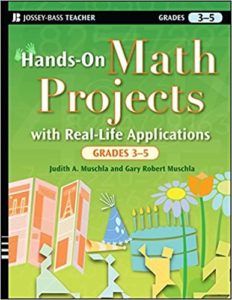 |
In similar format, see Judith Muschla and Gary Robert Muschla’s Hands-On Math Projects with Real-Life Applications (Jossey-Bass, 2009) for ages 7-10; and Joyce Stugis-Blalock’s Math Projects (Mark Twain Media, 2011) for ages 10 and up. |
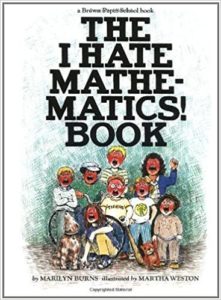 |
Marilyn Burns’s dynamic duo, The I Hate Mathematics Book (Little, Brown, 1975) and Math for Smarty Pants (Little, Brown, 1982) are wonderful 120+-page illustrated collections of math puzzles, games, and experiments designed to show kids that math – rather than a series of rote exercises – is an inventive way of thinking. Determine how close you can get to a pigeon, take a shoelace survey, make a topological map of your house, make sidewalk chalk shapes that can be drawn without lifting the chalk from the sidewalk or retracing any line. Highly recommended for ages 8 and up. |
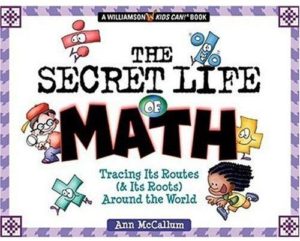 |
Ann McCallum’s The Secret Life of Math (Williamson Books, 2005) is an interactive history of numbers from prehistoric times to the present, illustrated with photographs of artifacts, puzzle and fact boxes, and timelines. In Part I, which describes mankind’s first forays into counting, kids make a tally stick with a chicken leg bone, learn how to count like a Zulu or a Roman, hold a native American nature count, and make an Inca quipu. In Part II, which covers the history of numerical symbols, kids make a cuneiform birthday tablet, learn to count in Egyptian hieroglyphs, and learn about zero and Fibonacci numbers. Part III leaps from counting to calculation: kids become “algorithm detectives,” tackle lattice multiplication puzzles, and make an abacus and a set of Chinese counting rods. Excellent for ages 9-12. |
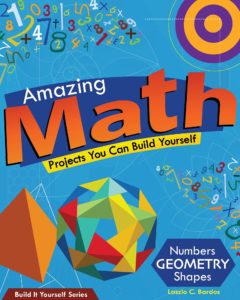 |
Amazing Math Projects You Can Build Yourself by Laszlo C. Bardos (Nomad Press, 2010) is arranged in four sections – Numbers & Counting; Angles, Curves, and Paths; Shapes; and Patterns – each of which features hands-on projects with instructions and templates, activities, interesting information in text and sidebars, and new word definitions in boxes. Readers learn, for example, about Fibonacci rabbits, four-color maps, and Koch snowflakes, and discover that a potato chip is in the shape of a hyperbolic paraboloid. The projects are cool. For ages 9 and up. |
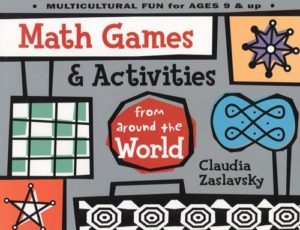 |
Claudia Zaslavsky’s Math Games and Activities from Around the World (Chicago Review Press, 1998) is a 160-page collection of multicultural math games, puzzles, and projects arranged by game category. Chapters include “Three-In-a-Row Games,” “Games of Chance,” “Puzzles with Numbers,” “Geometry All Around Us,” and “Repeating Patterns.” Kids can play 9 Men’s Morris or Mankala, experiment with hexagrams and Magic Squares, make Pennsylvania Dutch love patterns and Japanese Mon-Kiri cut-outs, and much more. Included for each game or project are background information, instructions, and “Things to Think About.” For ages 9 and up. |
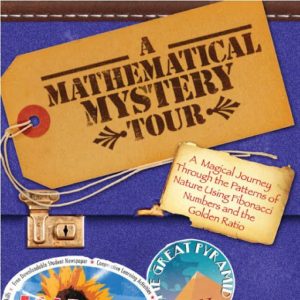 |
Mark Wahl’s A Mathematical Mystery Tour (Prufrock Press, 2008) is an interactive exploration of numbers in nature and art. For example, discover Fibonacci numbers in pinecones, daisies, and pineapples; learn about spiral galaxies and Plato’s polyhedra; and study geometry while building a model of the Great Pyramid. For ages 11 and up. |
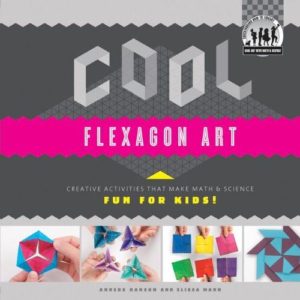 |
Anders Mann Hanson’s Cool Arts with Math and Science series (Checkerboard Publishing) has creative mathematical projects and activities with photo-illustrated instructions. Titles include Cool Paper Folding; Cool Structures; Cool Optical Illusions; Cool Tessellations; Cool Flexagon Art; and more. |
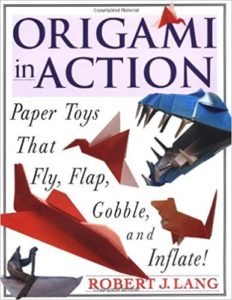 |
In Robert J. Lang’s Origami in Action: Paper Toys That Fly, Flap, Gobble, and Inflate (Martin’s Griffin, 1997), math/origami expert Robert Lang has instructions for everything from a flapping butterfly to (our favorite) a blow-up bunny. |
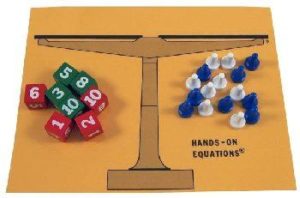 |
Hands-On Equations is an algebra program that uses fat red and green number cubes (representing positive and negative numbers), colored pawns (positive and negative unknowns), and a balance scale (printed and laminated) to teach kids how to set up and solve algebraic equations. Fun and clever for ages 8 and up. |
| |
TOPScience sells multi-lesson modules of coordinated hands-on learning activities for grades 3-10 – and these are extraordinarily clever in that they do a lot with truly simply materials such as pennies, tape, clothespins, and paper clips. Click on “Math and Measurement” for math-oriented units for a range of ages. Highly recommended. |
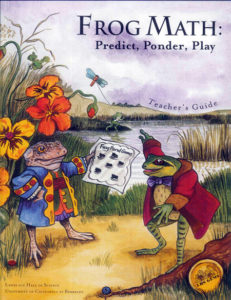 |
From UC Berkeley’s Lawrence Hall of Science, the GEMS (Great Explorations in Math and Science) Teachers’ Guides use integrated activities to teach science and math topics. Sample titles include Frog Math, Early Adventures in Algebra, In All Probability, Math Around the World, and Math on the Menu. |
| |
Hands-On Math Activities is a collection of printable games and projects, categorized under Numbers and Operations, Geometry, Problem Solving, Data Management and Analysis, and Measurement. For example, kids make and play pentominoes, experiment with geoboard sheets, build a Lego graph, and make and compare the capacities of paper cylinders. For ages 8-12. |
| |
Hands On Math is a helpful blog devoted to creative ideas for teaching math. Lots of interesting approaches and activities for a range of ages. |
| |
For older students, see Hands On Math in High School. |
| |
MathFour is a website devoted to creative approaches to teaching math. For example, kids can make Fibonacci Valentines, whip up a batch of mathematical eggnog, and research invented numbers (eleventeen?). |
| |
Patterns in Nature is a collection of cool interactive applets demonstrating math concepts. For example, find out how to compute pi by throwing darts at a dartboard and discover what ants in an anthill have to do with molecular motion. |














